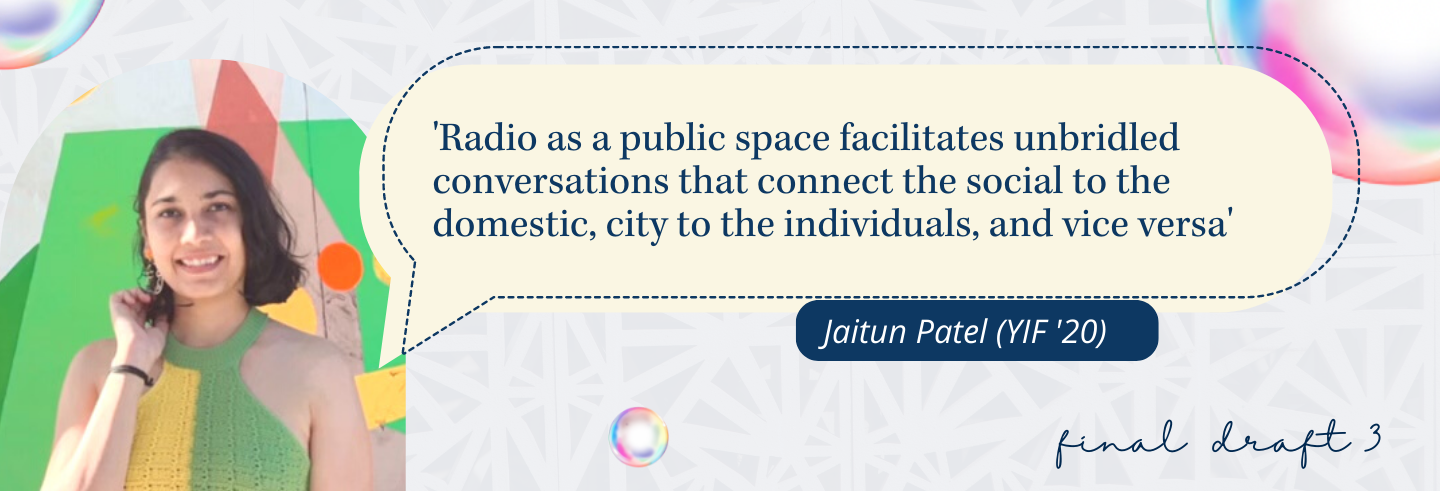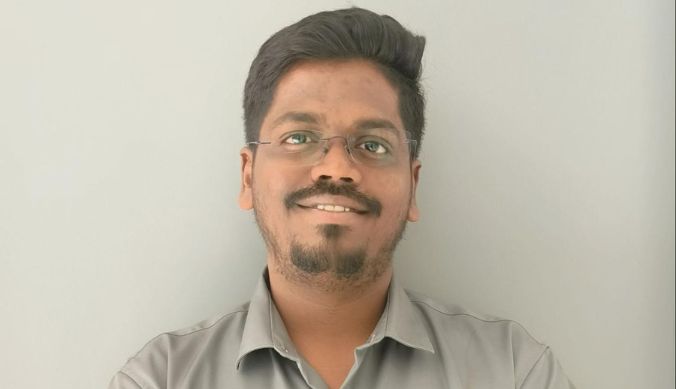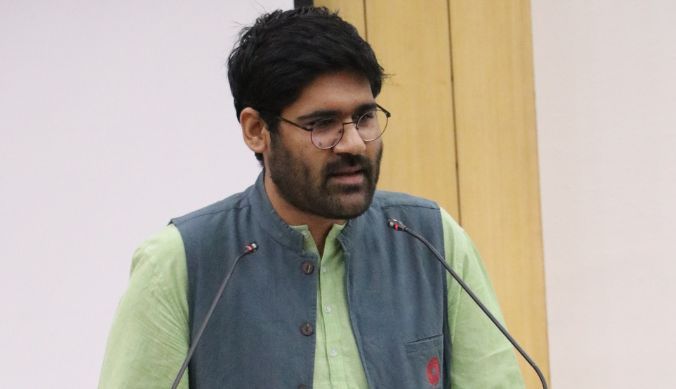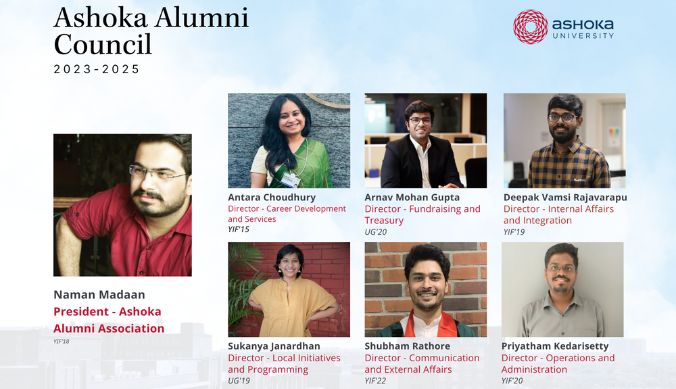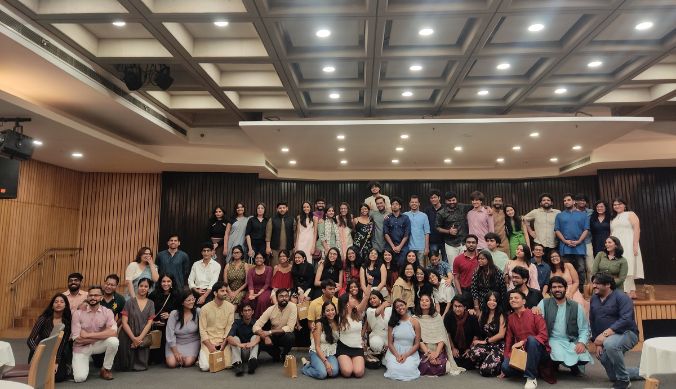‘Radio: A Public Ride to the City’
Featuring Jaitun Patel’s creative piece that developed as an original project over her term at the Young India Fellowship

Jaitun Vijaubhai Patel
24 November, 2022 | 6m readAbstract:
Jaitun Patel explores the uniquely urban nature of radio broadcasting, an ‘invisible media form’ that functions as a public sphere where community and city coalesce: “In the realm of internet, where the world can be searched through fingertips, radio has to offer an altogether different experience of the world”.
Article:
Cities can be reflected in the camera;
cities come into being on radio.
(Marek, qtd in Birdsall 129)
Squeak! Squawk! Frequency is tuned and voices from the radio begin to seek attention. In the era of television and video streaming, people have been habituated to perceive their surroundings through visual media, and there is a continuous switching between hearing and listening; putting constant pressure on these voices on the air to avoid getting lost in the surrounding activities. These voices desire and are able to pierce through the daily lives of listeners who would otherwise not let strangers penetrate their private boundaries.
Encountering these voices—consciously or unconsciously—in everyday settings, listeners become familiar with the presence of the space embedding them; floating alongside their routine practices. As a passenger boards the train, by turning on the radio button the listener boards on air. Entering the shared space, they embark on a journey to places while engaging with space itself. It also provides a window to the outside world. Just as the sounds of the engine, whistles, vendors, the chatter of the passengers, and the announcements on the railway stations are linked to a train journey, the sounds of radio’s physical equipment, tunes, announcements, advertisements, and voices over the medium form the sound sensorium of radio broadcasting. So, listening to the radio is analogous to travelling on a train. This paper first studies the public sphere and categorises radio broadcasting as a public space—shared and open. It also delves into the construction of this public space through the sounding, voicing, and listening aspects of radio. Employing this understanding, the production of the experience of urban space, the city, is traced. The role of this old media form in the construction, portrayal, and experience of the city is thus presented through this study.
Jürgen Habermas has put forth the concept of the public sphere as “a realm of our social life in which something approaching public opinion can be formed. Access is guaranteed to all citizens” (2). According to him, the public is an institution, and not a crowd, that takes form through the participation of the latter. So, when people get involved in unrestricted discussions of general interest, only then they behave as a public body (Habermas 2). Hence, freedom of speech and expression are integral to this space. This understanding is furthered with the concept of a deliberative public sphere: “space where collective and individual, popular and non-popular actors within a community have access to participate and have the possibility to add new issues to the discussion agenda” (Avritzer). As the exchange of ideas and dialogue defines the public space, it need not be physical in nature. Its constitution can be either through face-to-face or mediated spaces that, whether “interconnected or individually, correspond to a community” (Navarro 4)
Radio waves are everywhere: anyone with a receiver is just a tap away from accessing the space of the radio and, so, it guarantees unrestricted access. The connotations of a community, or public, with the radio are also found in the usage of slogans for the radio programmes like Bahujan Hitaya Bahujan Sukhaya (“For promoting the welfare and happiness of the masses”) and Informasi Dari Anda, Untuk Anda (“Information from you and for you”). A space modelled for common usage follows norms and modes of behaviour that guarantee public opinion, which include— a) general accessibility b) elimination of all privileges, and c) discovery of general norms and rational legitimations, as characterised by Habermas (3). However, tracing the history of radio in India, radio broadcasting was not part of the public domain nor did the audience engage with it as one. This was mainly because of the presence of stringent government control and political influence on the space that constrained the radio from being relevant to its listeners’ interests. It was only after the Supreme Court judgment of 1995, that declared airwaves as public property, that radio broadcasting was employed to serve the general interests of the public (Ministry of Information and Broadcasting vs Cricket Association of Bengal, MIB). Since then, airwaves have been owned by everyone and no one (Sarai 18). But, open gates of a park only fulfil the first norm of Habermas’s idea of the public sphere; they are not sufficient for the citizens to publicly engage with the space. Only when radio broadcasting serves the interests of anyone and everyone who can receive its signals, can it be leveraged for the formation of public opinion. Hence, ownership sets the necessary precondition in removing the barriers for access but is not sufficient for the construction of public space.
“For those who go from home to work, and commute long hours to come home again, public space is basically the interminable zone between work, and rest, in order to go back to work again” (Sarai 2). These commuters might not be accompanied by someone but they know that in those interminable zones they are not alone, that they are part of a shared space. The scenario is not very different for radio broadcasting. The radio is very clearly present in these interminable zones, and it is itself one. Tuning in the radio in leisure time, in the bathroom, while cooking, driving home, on the way to the office or in traffic jams, commuters choose to be part of this parallel ‘on-air’ space that is spread endlessly and penetrates all visible boundaries. With the advent of mobile phones and headsets, this space is ever-expanding and now, accessible even at the office desk, on trains, and on buses. Additionally, listeners can tune in to radio programmes of any region—local, national or international. Thus, the private, public, national, and international are all fused and open on-air. Listeners, although connected to the radio in their own personal spaces, are aware of the presence of a larger audience—that the space is simultaneously occupied by others. It is this common and simultaneous use of the space that shapes the very idea of publicness. Listeners are connected in/ through the same medium and yet are distant. Moreover, they are aware of this distance and still carry the sense of togetherness. It is the radio’s feature of intimacy-at-a-distance that this paper interprets in the context of the public space.
The space of radio broadcasting is purely a creation of sound and voices that travel through the ether; which is invisible yet physical. For this identity rooted in the sense of sound, radio has various associations of the oral and aural in its construction as a public space. There is usually no face to the voice heard on the radio, and so, on-air interactivity is restricted to speech. This puts the requirement on the space to be listener-friendly. In their friendly tones, the radio hosts should sound ordinary— one amongst the audience—and be or seem to be themselves (Tolson 8). With thousands of ears on them, a naturalness in the tone is vital in order to handle any unexpected situations (especially in live shows), and maintain the illusion of liveliness (for recorded programmes) and spontaneity (in both recorded and live shows). Furthermore, the hosts only have their microphones to talk to; the visual audience is absent. Speaking amid such contrasting shades—of being conscious and being oneself, friendliness and strangeness, natural and scripted, absence and presence—transforms the hosts into actors and their speaking into performances. Jurriëns, in his case study on Indonesian radio programmes, has discussed the diverse roles the hosts play. One of these roles is that of ‘counselor-therapist’—lightening the mood of their audience through relaxed and humorous conversations. “By discussion and releasing the tension from controversial issues, the hosts attempt to free people from their frustrations and console them” (Jurriëns 8). Through such oral performances, radio hosts establish a connection with the listeners and enable them to stay tuned in.
“It is raining outside and there’s a touch of the cool breeze … so, your RJ brings you this song. Enjoy listening and stay tuned.” Such instances are not uncommon when the hosts make use of the common physical surroundings, ‘the present’, to associate with the listeners and extend into their space. Radio talk shows as described by Andrew Tolson are the “presentation of self” in everyday life (5). The wide receptivity of radio signals enables the utilisation of radio alongside routine activities, especially while driving, in the kitchen or in the fields where the scope of visual attention is absent. “It blends in with the domestic life that surrounds it, either competing with other activities or accompanying them” (15). Moreover, usage of collective pronouns—we, us, all, everyone—explicitly tells the listeners about the presence of several others. It sets up the notion of a shared space. However, radio broadcasting is more than one-way performances and involves elements of interactivity which, in turn, transforms it into a public space.
The audience on the radio is not always on mute. Interactivity as per Edwin Jurriëns is the ‘talk-back’ or ‘phone-in’ feature of radio where the audience can connect to the host onair, participate, and even contribute to the radio programme through a telephone (2). Listeners can access and engage in the space without requiring a self-declaration; a space of sounds has no faces. So, radio broadcasting is comparable to the public domain that “has historically signified a kind of happy nameless, effaced existence” (Sarai 4). Such anonymity enables the building of a relationship on-air while getting involved with the radio. For instance, in the case of the community radio Kalyani in West Bengal studied by Bonita Aleaz, “The listeners of the programme came to symbolise a person named Kalyani with whom they could communicate on a no-holds-barred basis” (Aleaz 30). The broadcasting centre received thousands of letters addressed to Kalyani from men and women of various age groups. Of them, letters from women, particularly Muslim women were considerably larger in number. These letters, rather love letters, were an outlet for emotions and the expression of intimate feelings that were usually constricted for women in social settings. The invisibility of the airwaves removed “the constructed formalisms of interpersonal social communication consciously created and upheld by society” for women (Aleaz 31). Similar was the case with the category of letters from male counterparts who considered Kalyani the only hope to live with their increasing age and loneliness. Such emotional outpourings were unusual, as pointed out by Aleaz, among the society of rationally thinking men (31). Radio thus engenders interactions through other mediums and creates avenues for the otherwise restricted subjects to enter the public sphere. The formation of these counterpublics “widen the field of discursive contestation, meaning they bring to the fore issues that might have been overlooked, purposely ignored, or suppressed by dominant publics” (Kampourakis). Radio thus nurtures diverse participation from society and closely resembles the Habermasian model of the public sphere.
Community radio, in particular, is set up with the goal to bring marginalised voices to the centre, “to give voice to the voiceless”. In the case of Kalyani, the programme format and radio’s embedded anonymity empowered its listeners with a buffer for an emotional outlet. On similar lines, Vinod Pavarala mentions three instances where the usually unheard voices used their access to the radio for community building and empowerment: tsunami alerts broadcast by a local woman that saved Vilunthamavadi village in Tamil Nadu from the havoc of the 2004 tsunami; the recording of over a thousand songs in Bundeli through a community radio show called Bundeli Idol hosted by the women of Orchha village in Madhya Pradesh; and the Telugu talk show that explores critical social issues through gossip between sisters-in-law. These instances demonstrate community participation, ownership, and management of the broadcasting space. It also highlights the role of radio in “enabling marginalised communities to use the medium to create opportunities for social change, cohesion, and inclusion as well as for creative and cultural expression” (Pavarala). Besides, radio connects the audience to the outside world by eliminating all privileges and preserving their identities.
Similar to the way railways connect distant parts of the country to its city centres, radio links every end receiver to its radiating urban centres—the cities. Historically situated in cities, radio emanated to the periphery of the city; speaking and listening to the margins—often the rural. While its physical presence has expanded with the development of regional and local radio, the urban association of the radio still remains intact. For example, the knowledge about the location of broadcasting centres in the cities maintains the conception of radio as belonging to the urban. The apparent changes in language usage and content of radio programmes are other factors contributing to the urban influence. “The different languages used interchangeably and without translation, can be heard as a metaphor of the multiculturalism that came with the development of the vast modern city” (Karathanasopoulou and Crisell 8). The production of broadcasts in English and the creation of FM Rainbow by All India Radio (AIR) to serve the ‘modern’ taste of pop music are a few other examples.
The reach of radio across the boundaries of the nation portrays the picture of the developing world. The opening of the global boundaries and the emergence of the world market are very well heard on the radio. “In other words, a new aesthetic of broadcasting is being created on-air as a metaphor of the new ways in which the world is going to function” (Karathanasopoulou and Crisell 8). Moreover, as this information is routed through the city’s radio broadcasting centres, and cities are perceived as links to the global. Radio reaffirms the distinctiveness of the city (from the rural) and lets its listeners understand the urban by transmitting information about the notions of city life; often marked by the effects of industrialisation: fast-paced, concentrated with intense activity, and increased connectivity (both with the rural and the global). The notion of ‘internationalisation’ due to radio’s ability to tune in to far-away sounds, therefore, burnishes its urban image (Birdsall 25). Aerial Congestion— dense terrace spaces with antennae and radio receivers—also confirms the urbanity of the invisible radio waves in the visible landscape of the cities (9). The increased reach of radio has been followed by the intrusion of tech apparatus in homes and the association of new sounds with the apparatus (6). These new—at times unexpected— sounds are of the urban environments, of the development of the new world, a world that is accelerating.
Urban can be both documented and imagined through the radio, through the sound and the aural. Carolyn Birdsall has discussed the use of sonic dimensions for the depiction of the urban. Capturing the sounds of the cityscape—the sounds of harbour, steam engines, railways, cars, and also outdoor broadcasting—facilitates the audience’s visualisation of the city (Birdsall). However, only the sounds of the urban landscape cannot convey the unique essence of a city. So, radio announcers play an important role in creating the sonorous portrayal of the visual through speech, music or sound effects (Bodenstedt 45). For example, the change of place from Ahmedabad to Bengaluru is not felt merely upon reaching the Bangalore airport or entering the city. Visual cues of the pleasant weather or the location update in phones are not unavailable, but it is only when the radio in the taxi screams “Namma Bengaluru”, and with songs playing in Kannada, that one truly feels the change of city landscape. Similarly, Delhi, being the national capital, is indicative from the usage of Hindi, the official language of the country, on all its radio channels. “Radio forces people to objectify the senses anew, and in doing so, it opens a space by which the ontological—senses of being-in the-world—is also objectified, cited, expanded, and reproduced” (Bessire et al.). Thus, locally occasioned speeches, along with the characteristic sounds of the place, deliver a flavour of the city to the listener on the radio.
These speeches and conversations fostered by radio, as a public space, deal with public affairs and should be categorised under public speaking. Public speaking, as presented by Stewart, “offers an important forum for the dissemination of ideas about the city and the urban experience, for the construction of the city’s ‘imaginative structure’” (49). So, radio is “a site for the discussion of the city itself, a place in which the city could be—and is—constructed through discourse” (Stewart 49). The broadcast of local news, for instance, familiarises the listeners with the city’s spatial and cultural elements. Listening to the news occurrences with references to North, South, East, Central, and West Delhi, creates a mental impression of the local happenings and helps to situate oneself in the city. Radio interactions with the people, local bodies, and government officials also build an understanding of the local context of the city. Entertainment programmes, on the other hand, provide the best knowledge of a city’s culture, for the dialect and use of language by the hosts are closest to the people of the area. Advertisements, mainly the local commercials, are another source of knowing the city on-air as they are linked with the popular/demanding facets of the city. For example, the frequency of commute options and sale commercials, or event announcements, in Bengaluru depict the traffic problems and weekend tastes of the city dwellers. So, the voices embodying the city take the listeners on a trip to imagine, explore, and experience the city on-air.
However, the experience of the city built by the radio is different for the locals compared to those who are new to the city. Richard Foreman, in his excerpt from a play, has portrayed the role of radio in his exploration of a new city:
What I can bring back from my
day exploring the city—?
It vanishes.
Therefore, the city might have
been endless. On the other hand,
it might
have been a disappointment.
That is one of the reasons I so miss
having a radio in my room. If there
was a radio in my room I might,
now, turning it on for myself,
hear—intuition-wise—what I
missed, or lost, in my meticulous
exploration
turned back toward me. (Foreman
136)
The sounds and voices of the radio, unlike a tourist itinerary, are not situated only around the monumental cities. They are instead embedded in the routine practices of the city life and so, offer an entry into the city’s everyday reality—as the processions of Republic Day at the Red Fort are unique to Delhi but not unknown to outsiders. However, the frequency of Punjabi songs and repeated mentions of the metro do point at its demographics, and the public’s inclination and usage of the Delhi metro. Besides constructing the cityscape, radio is also a window to experience the city. Even if one is familiar with the city, radio creates opportunities for new engagement; for example, a random song on the radio can evoke the experience of the streets of a common route afresh for listeners. Furthermore, the usage of deictic language enables the audience to travel across space and time and enter the realm of an imaginative yet existent space. For instance, Mahatma Gandhi and Jawaharlal Nehru, who still make their ‘live’ appearances in 21st century India through their speech broadcasts from Delhi, putting forth a distinct image of the present-day city. So, radio offers a dive into the cityscape that is not unknown, but the way it reveals itself may no longer leave it known either. The liveliness and spontaneity of radio enables the listeners to visualise the city and move across it while “demonstrating that an ongoing commitment to immediate communication lay at the heart of the modern media-dominated city” (Stewart 154). These interactions with the city are constantly shaping the formulated image of the city, adding dimensions from its own inhabitants.
“This city, as it is constantly reimagined and reconstructed through very large-scale conversations in electronic space, and as it shapes and steers that form of public speaking, is a virtual entity that contains the potential to surprise the actual city” (Stewart 179). Radio as a public space facilitates unbridled conversations that connect the social to the domestic, city to the individuals, and vice versa. When individuals tune in to the radio, it constitutes a public sphere, as defined by Habermas, where “private individuals assemble to form a public body” (2). This public body then carries with itself a sense of collective, of community. The sounds and voices that embody the space of radio often become the voice of the community. Public spaces do not exist as standalone spaces. So, the formulated on-air space, also an embodied urban space, constantly interacts with the spaces that contain it—the cities and those contained within—the on-air community. “The city of the future, then, need not be conceived merely as a simulation of a built environment; instead, it can be visualized as a complex network of speech sites, as an entity formed through digital speech” (Stewart 179). Sounds travel through the air and so, to their listeners, radio broadcasting is transformed from a site of communication into that for loitering and engaging in the space it creates and the one it is situated in. Radio can be thus characterised as a public ride to the cities.
About the Author:
As a person who is often quiet in the verbal world, finding expression in written words has been both stimulating and empowering. Driven by the curiosity to know the world better, I joined Ashoka, until which—as a computer engineer—I had hardly engaged with writing to voice my thoughts. Critical writing has been the heart of my writing experience at Ashoka, and the reflection writing and sharing in those classes is what I enjoyed and remember the most. It was like visiting a flower shop—where you come across a variety of flowers and are free to choose as well as create your own bouquet. Always intrigued by the possibilities of giving form to my learning and observations, writing this piece has been a similar pursuit—digging into my experience of listening to the radio and dwelling in different cities. I am thankful to my preceptor, Prateek Paul, for his efforts and support, and even more for introducing the theme of Writing the City. As a first-time visitor and a short-term resident, I know Delhi/Dehli/Dilli much more than ‘things to do’ while there.
I am a student at Virginia Tech pursuing Master’s in Computer Science and Applications, studying Human Computer Interaction with an interdisciplinary focus on Technology for Sustainability. I am passionate about design and social-change and I seek to build a career at the intersection of design, technology and social sciences. Currently, I am a Product Design and Management intern at Stanford Health Care.
About YIF CW Programme:
The YIF Critical Writing programme is a unique, one of a kind opportunity for Fellows to hone their critical thinking and writing skills under the able supervision of trained experts in the field. The CW programme employs a constantly evolving pedagogy, making learning and knowledge production more collaborative and dialogic. Preceptors at the YIF CW programme teach writing through a range of topics including but not limited to ‘History, Philosophy, and Anthropology of Science’, ‘Politics of Language and Multilingualism’, and ‘Education, Literacy, and Justice’.
About Final Draft:
The Final Draft is the annual journal of the YIF Critical Writing programme. It showcases the range in topic and genre, as well as the strength of writing in the highly diverse YIF student body. These pieces of writing, submitted by Fellows from various classes of the YIF represent only a small fraction of the variety and range of writing done over the years.
About our campaign:
Through our ‘Final Draft 3’ campaign, we hope to give you a glimpse into some of the styles and voices that have evolved, the concerns and ideas that fellows have explored, and the seriousness of their engagement with writing as drafts in motion; searching for meaning and connection, which makes this more of a pedagogic exercise book.
(The piece was first published in the Final Draft, A Journal of the YIF Critical Writing Programme.)





